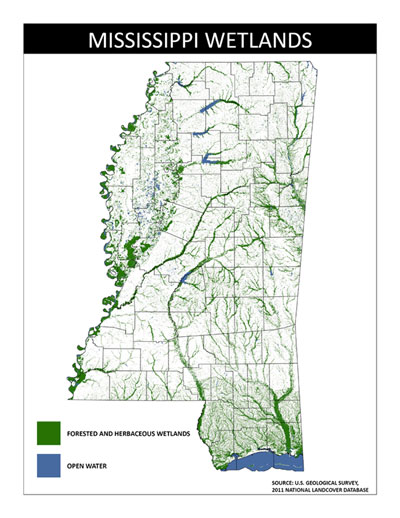BOTTOMLAND HARDWOODS/WETLANDS

HABITAT DESCRIPTION
Bottomland hardwood forests are found along the Mississippi River and throughout
the state along other rivers and streams. The largest patches cover 50,000 to 100,000
acres and are found in the Mississippi Delta and along the Pascagoula and Pearl
rivers. Bottomland hardwood forests cover nearly 7 percent of the state’s land area,
or about 2 million acres. Seasonally flooded forests cover another 600,000 acres
in the state.
WILDLIFE MISSISSIPPI PROJECTS
- Conservation easements, acquisition and restoration through Wetlands Reserve Easements,
the Conservation Reserve Program, Partners for Fish and Wildlife Program and the
Wildlife Habitat Incentives Program.
- A majority of conservation work on bottomland hardwoods and wetlands is in the Mississippi
Delta, with projects also along rivers and streams such as the Buttahatchie River,
Coldwater River, Pearl River, Wolf River, Bayou Pierre, Bull Mountain Creek and
others.
- Management of moist-soil areas to provide habitat for waterfowl, shorebirds and
other migratory birds.
- Participation in the regional Lower Mississippi River Batture Reforestation Project,
a joint effort of the Mississippi River Trust, Lower Mississippi River Conservation
Committee and Natural Resources Conservation Service.
- Development of incentives for private landowners to protect, restore and enhance
bottomland hardwoods and wetlands.
POPULAR SPECIES
White-tailed deer, wild turkey, squirrels, rabbits, barred owl, prothonotary warbler,
pileated woodpecker, wood duck and mallard.
SPECIES OF CONCERN
Louisiana black bear, wood stork, swallow-tailed kite, cerulean warbler, Swainson’s
warbler, rusty blackbird, various bats, blackmouth shiner, backwater darter, one-toed
amphiuma and river frog.
BENEFITS
- Larger bottomland forest tracts, particularly those in the active floodplain of
the Mississippi River, support increasing populations of black bear. Forest corridors
along the Mississippi and other rivers and streams are important for migrating and
nesting songbirds and various wading birds. OIder forests are critical habitat for
many bat species.
- Hunting, fishing and wildlife watching opportunities abound. Mississippi’s bottomland
forests support some of the nation’s best hunting for white-tailed deer, wild turkey
and wintering ducks. Concentrations of wading birds such as egrets, herons, wood
stork, white ibis and roseate spoonbill make for spectacular birding opportunities.
Migrating and nesting songbirds also provide great birding opportunities.
- Bottomland hardwood forests and wetlands, particularly those along rivers and streams,
filter nutrients and other water pollutants.